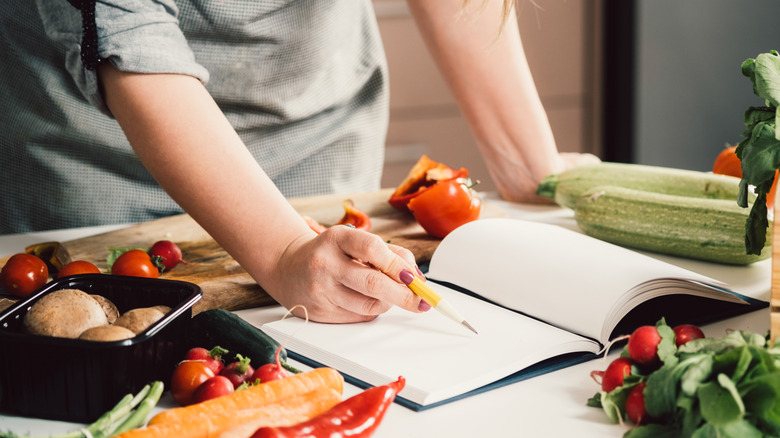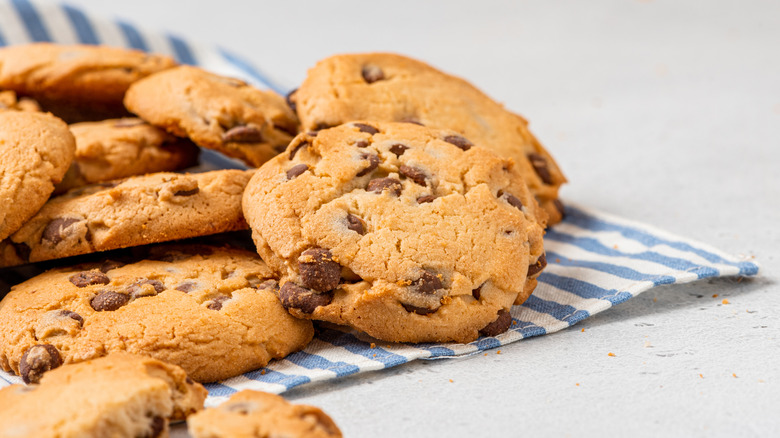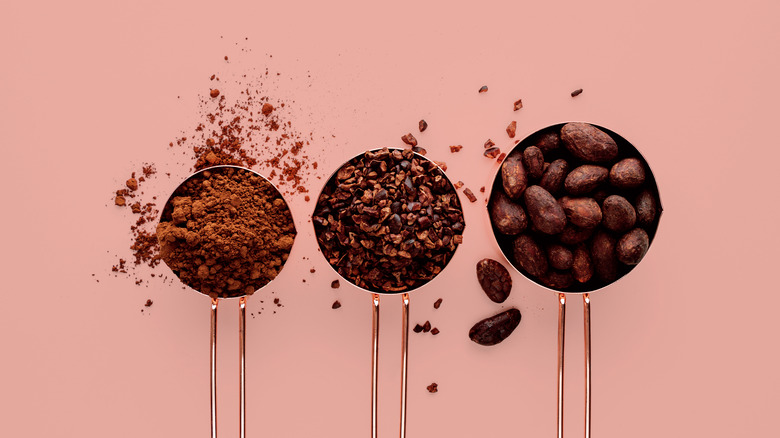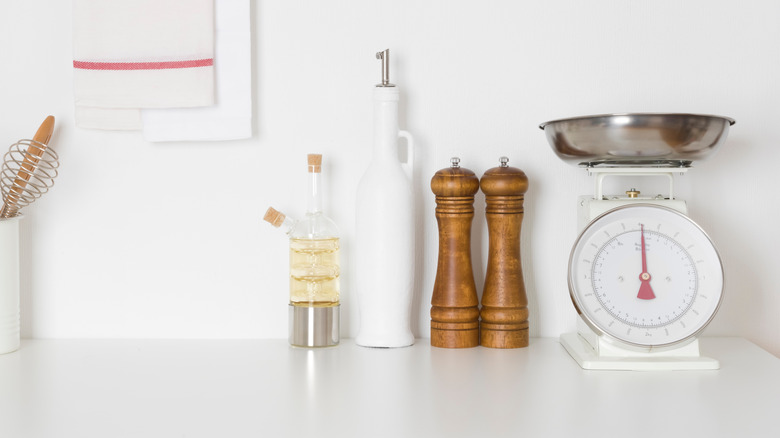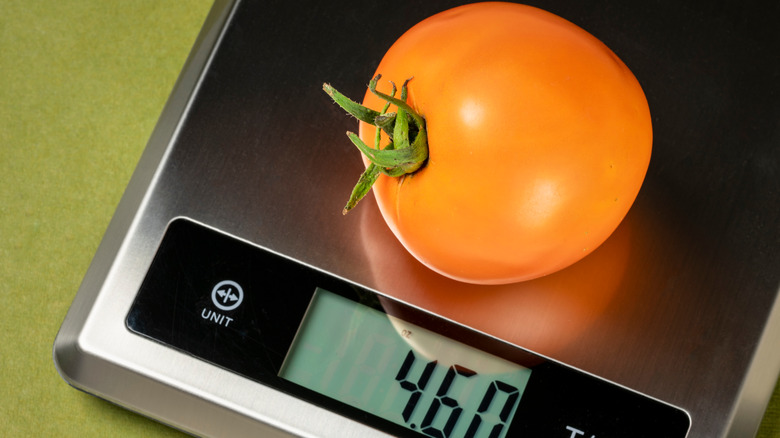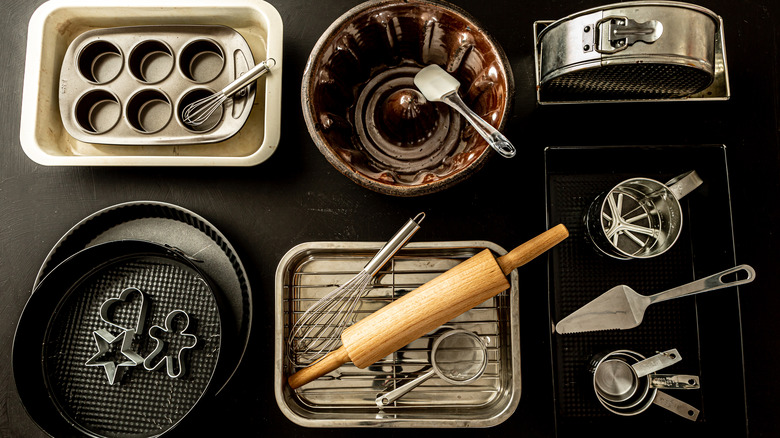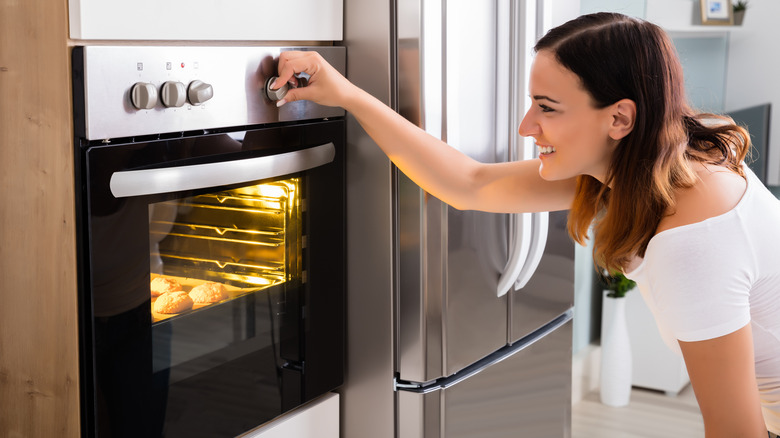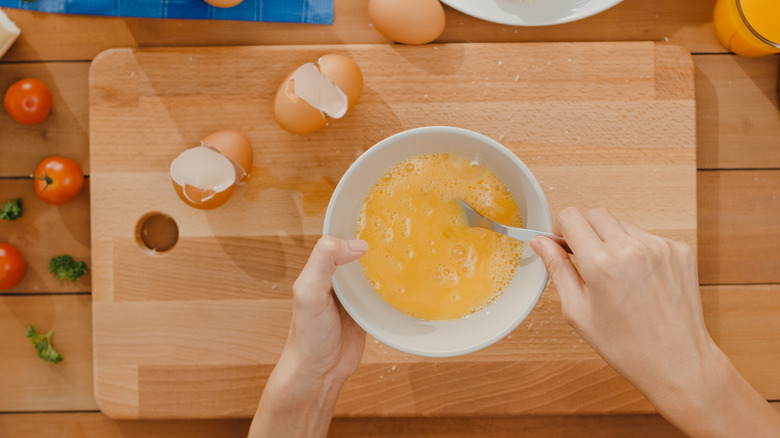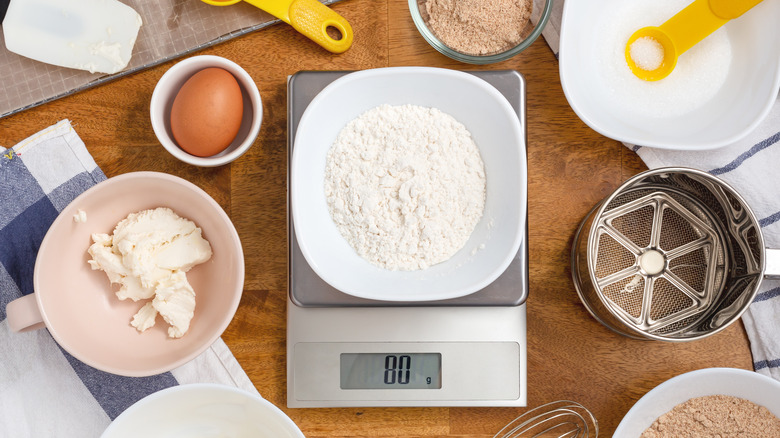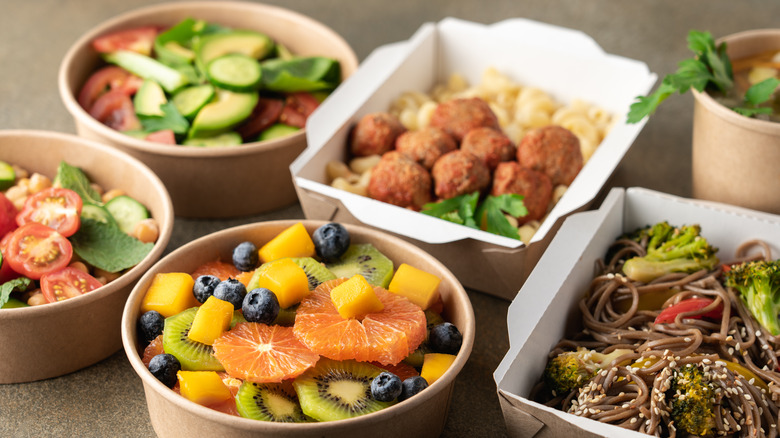Here's The Right Way To Cut Down Recipes
We may receive a commission on purchases made from links.
Everyone loves a fantastically delicious meal from a recipe that has no trouble feeding a small army. Sometimes, this is ideal. For example when you're prepping for a party or if you're planning Sunday night dinner for the whole family. There may be other times where you just want it as a nice meal for yourself. You can make all the cookies and the entire stew ... but what do you do with the leftovers? You can freeze them if you have the room or maybe eat them all week for lunch. But what if you don't have the room in your freezer? Or if you hate leftovers? Or you don't have the time to cook such a big meal? It just so happens we have that solution for you — cut down the recipe. It might sound easy, but there are things you should know, tips to make scaling down a recipe easier, and why you should consider doing it.
Why bother cutting down a recipe?
In case you haven't run into this issue yet, cutting down the size of your recipe can help in a few different ways. The first is by reducing the amount of waste. If you hate throwing out extra food and you cannot eat anymore, scaling down the recipe is a great option for you. You will also have fewer leftovers hitting their expiration date when you realize you can't eat them all in a week. If you have a smaller refrigerator, you might not be able to store the Tupperware filled with extra food, in addition to your weekly groceries.
Cutting down recipes will leave you with plenty of space for your week's worth of meal-prepped salad. Finally, reducing the servings in a recipe can be more budget-friendly. When shopping for groceries for the week, you can pick up half or a third of the meat, produce, and dairy you will need for the smaller recipe. Ultimately saving you money in the long run.
How to reduce common measurements
Going from a cup of flour to half a cup is an easy conversion to make. But what happens when the original recipe calls for a third? Online resources such as UNL food have charts to help you quickly figure it out. Such charts include everything from how to half a tablespoon, to what one-third of two-thirds is! Another conversion to know when cutting down a recipe is how many tablespoons and teaspoons are in different measurements. For example, one cup is equal to 16 tablespoons and 12 teaspoons are in one-fourth of a cup. Recipellion has a phenomenal chart you'll want to bookmark.
If you prefer to look away from a screen while cooking, there's a fun trend to help with measurement conversions. People are hanging their measuring cups and spoons on the inside of a cabinet door and including the measurement conversion chart there! Pinterest has an example of what one can look like, and it's a DIY project one might find helpful!
Once familiar with the way measurements are converted, your chef status will be elevated and you'll be ready to cut any recipe — including larger meals cheeseburger soup or shepherd salad.
Using a scale to cut down your recipe
If you haven't weighed your ingredients before this could be the beginning of a new era. According to Taste of Home, weighing baking ingredients is the best way to make sure each ingredient is completely accurate. As opposed to measuring cups that measure volume, a baking scale provides much more accurate measurement and you'll have a true ounce of flour for your recipe, rather than a volume measurement.
Using the original recipe, divide the original amount of ingredients to the desired size and convert that to grams (how most baking scales weigh items). Place the ingredients on the scale and watch the numbers if using a digital scale. Then voila — you have a perfectly measured ingredient! It's perfectly measured because there is no cup or item taking away from the total required amount. For example, if the recipe calls for "lightly packed brown sugar." Again, we like to help make your life easier and a good ingredient conversion chart can go a long way in assisting with your cooking measurements.
Kitchen scale recommendation
Not only will a kitchen scale improve your cooking accuracy, but it will also help you consistently produce the same incredible results each time you cook. The Food Network shares that while accuracy is necessary, versatility in a scale is important too. You'll want to make sure the scale is correct while measuring small and large amounts. From a couple grams of sugar to a large helping of crushed tomatoes for sauce. The Nicewell Food Scale on Amazon is sturdy and has a large LCD display. You can read our full review of the product here on Mashed. We think you'll really like it! The New York Times' Wirecutter describes a kitchen scale as a "secret weapon," that gets your baking, "down to a science." Just think of all the different types of food you'll become a master at cooking when you've got your very own scale!
Updating your pans for cutting down your recipe
Changing the type of vessel you are cooking in is not always necessary. It depends on the recipe. All Recipes says you can usually bake cakes in smaller vessels without any issues.
However, if that isn't the case, we've got a way to scale down your pans the right way. Once you decide what you are making and how much you need to cut the recipe down, it is time for basic math. By using the recipe instructions, you can find the area of the pan and reduce the size of the batter and pan together. Taste of Home shares this example: if the recipe calls for a 13x9 inch pan, you would multiple 13x9 to find the area ...117 square inches. If you don't have the pan the recipe calls for, you can find the area of your pan and compare it to what is requested. You'll be able to find the difference between the pans and adjust the recipe (scale down or up) accordingly.
Most people usually have the same size pans at home. Pans for baking cakes, a bread pan, large skillet, medium skillet, muffin pan, and a 13x9 dish are great for casseroles and brownies. However, a chart for options, if you do not have the pan required, can be incredibly useful to have on your phone or stashed in a kitchen drawer.
Are cook times impacted by cutting down recipes?
When scaling your dish down, it might be necessary to also reduce the cooking time. Depending on the volume of the vessel you're using, it may cook a little bit faster. MasterClass recommends setting your kitchen timer to the halfway point to ensure you don't over or undercook the dish. From there, check the dish every five minutes to ensure it does not over-or under-cook. If you're using a pan that has a smaller area and is probably deeper, the recipe might take longer to cook. Follow the same tip provided above, but poke a small hole in the center of the food. If you pull the fork, toothpick, knife, or whatever object you're using to poke a hole, out and there are food remnants on it ... it needs a little more time to cook. When you pull the utensil out of the center and it is clean, it is time to take it out.
Tips and tricks for scaling down eggs and spices
When reducing a recipe, sometimes you'll hit a barrier when the ingredients require three (or another odd number) of eggs. Taste of Home says the easiest way to scale down these ingredients would be to combine three cracked eggs in a liquid measuring cup, beat them with a fork until they are completely liquid and combined. Then pour half into a spare bowl and BAM there is your one and a half eggs. You could also use a kitchen scale if you have one available. Remember to write down the number, divide by the amount you're scaling the recipe down by, and pour the remaining out.
When it comes to spices and seasonings, instead of trying to measure these out exactly, the Cookie Rookie says it might be easier to use slightly less than half the seasoning and simply taste as you go. This way your recipe will be cooked how you like it and not be lacking the extra kick of flavor from the seasonings.
Things to remember when scaling down a recipe
We know there were a lot of recommendations, numbers, and conversions listed throughout this article but if you can only take away three items let them be:
1) To help divide all recipes remember UNL's basic conversions and you'll find this process much easier:
1 cup = 16 tablespoons, 1 tablespoon = 3 teaspoons, 1 cup = 8 fluid ounces, 1 fluid ounce = 2 tablespoons, 1 pound = 16 ounces, 1 pint = 2 cups, 2 pints = 1 quart
2) If you're trying to decide whether it is worth it to reduce your recipe, make sure you don't have room in the freezer. Especially with cookie dough or sauce. Cookie Rookie points out it may be easier for you to freeze the extra and take it out whenever you're craving a sweet snack or savory meal.
3) If you're switching out the type of vessel you're cooking in, The Food Network points out you should pay attention to what the dish is made with. For example, if you're switching from a non-stick pan to stainless steel, the stainless steel pan will heat up faster. You'll need to remember cook times might be shorter for this specific pan to make sure you don't burn your food.
Be patient when cutting down recipes
The thought process and reasoning behind cutting down a recipe is something every chef needs to learn on their own. Whether the reason is that you need more time to binge "Grey's Anatomy" and other can't-get-enough-of TV shows ... like a certain writer might *winks* or you are starting 2022 with a resolution to be less wasteful. Scaling down a recipe might be the answer to all of your problems. Remember — be kind to yourself as you are learning how to find the area of a pan or how to bake a smaller batch of muffins without having them come out lumpy and halfbaked. It might take you a few tries to figure out exactly how to cook the smaller meal but have faith, you will figure it out eventually! You're going to make a fantastic dish for the perfect amount of people and it'll be just as delicious as the original. Happy cooking!
